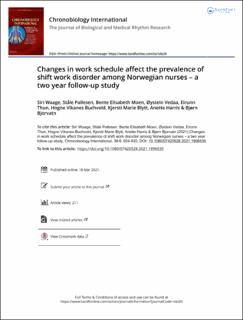| dc.contributor.author | Waage, Siri | |
| dc.contributor.author | Pallesen, Ståle | |
| dc.contributor.author | Moen, Bente Elisabeth | |
| dc.contributor.author | Vedaa, Øystein | |
| dc.contributor.author | Thun, Eirunn | |
| dc.contributor.author | Buchvold, Hogne Vikanes | |
| dc.contributor.author | Blytt, Kjersti Marie | |
| dc.contributor.author | Harris, Anette Kristoffersen | |
| dc.contributor.author | Bjorvatn, Bjørn | |
| dc.date.accessioned | 2022-04-27T06:41:57Z | |
| dc.date.available | 2022-04-27T06:41:57Z | |
| dc.date.created | 2021-06-17T16:36:42Z | |
| dc.date.issued | 2021 | |
| dc.identifier.citation | Chronobiology International. 2021, 38 (6), 924-932. | en_US |
| dc.identifier.issn | 0742-0528 | |
| dc.identifier.uri | https://hdl.handle.net/11250/2992931 | |
| dc.description.abstract | This study aimed to explore how changes in the work schedule would affect the prevalence of Shift Work Disorder (SWD) over time. Two-year follow-up data from 1076 nurses participating in the longitudinal SUrvey of Shift work, Sleep and Health among Norwegian nurses (SUSSH) were included in the study. The questionnaires included measures of work-related factors, i.e., work schedule and numbers of night shifts and quick returns (QRs) worked the last year, as well as questions related to SWD according to the ICSD-3 diagnostic criteria at both baseline and at 2-year follow-up. Data were analyzed with paired samples t-tests, chi-square tests, and logistic regression analyses adjusting for sex and age. Terminating night work was the strongest predictor for recovering from SWD from baseline to follow-up (OR 10.91, 95% CI 6.11–19.46). Additionally, changing the work schedule from day work to night work from baseline to follow-up was the strongest predictor for developing SWD in the same period (OR 4.75, 95% CI 2.39–9.47). Reductions in number of nights (more than 10) and QRs (more than 10) worked the last year were associated with recovering from SWD between baseline and follow-up. Nurses who recovered from SWD had significantly reduced the mean number of night shifts worked the last year from 32.3 at baseline to 20.4 at follow-up (p = .001). Furthermore, an increase of more than 10 nights or more than 10 QRs worked the last year between baseline and follow-up predicted developing SWD. Nurses developing SWD between baseline and follow-up had significantly increased the mean number of nights worked the last year from 25.8 at baseline to 31.0 at follow-up (p =-.043). Changes in night work exposure were the strongest predictors for both recovering from or developing SWD from baseline to follow-up. Reducing exposure to night work and QRs were associated with recovering from SWD and increasing exposure to night work and QRs were associated with developing SWD. The results imply that unfavorable work schedules play a role in the development of sleep problems among nurses. These results may be useful when designing healthy working schedules. | en_US |
| dc.language.iso | eng | en_US |
| dc.publisher | Taylor and Francis | en_US |
| dc.rights | Attribution-NonCommercial-NoDerivatives 4.0 Internasjonal | * |
| dc.rights.uri | http://creativecommons.org/licenses/by-nc-nd/4.0/deed.no | * |
| dc.title | Changes in work schedule affect the prevalence of shift work disorder among Norwegian nurses–a two year follow-up study | en_US |
| dc.type | Journal article | en_US |
| dc.type | Peer reviewed | en_US |
| dc.description.version | publishedVersion | en_US |
| dc.source.pagenumber | 924-932 | en_US |
| dc.source.volume | 38 | en_US |
| dc.source.journal | Chronobiology International | en_US |
| dc.source.issue | 6 | en_US |
| dc.identifier.doi | 10.1080/07420528.2021.1896535 | |
| dc.identifier.cristin | 1916540 | |
| dc.relation.project | Nordforsk: 74809 | en_US |
| dc.relation.project | Helse Vest RHF: 911386 | en_US |
| cristin.ispublished | true | |
| cristin.fulltext | original | |
| cristin.qualitycode | 1 | |

